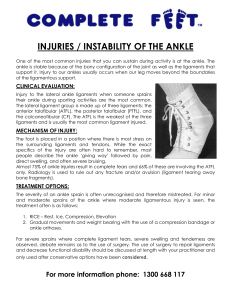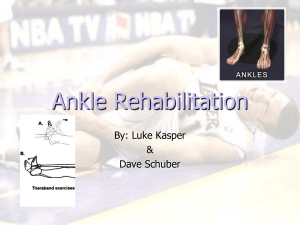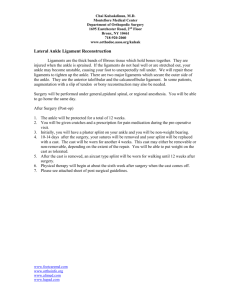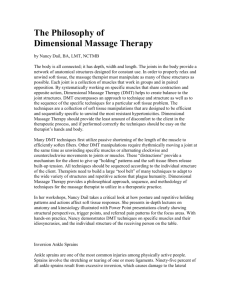prevent an ankle injury.
advertisement
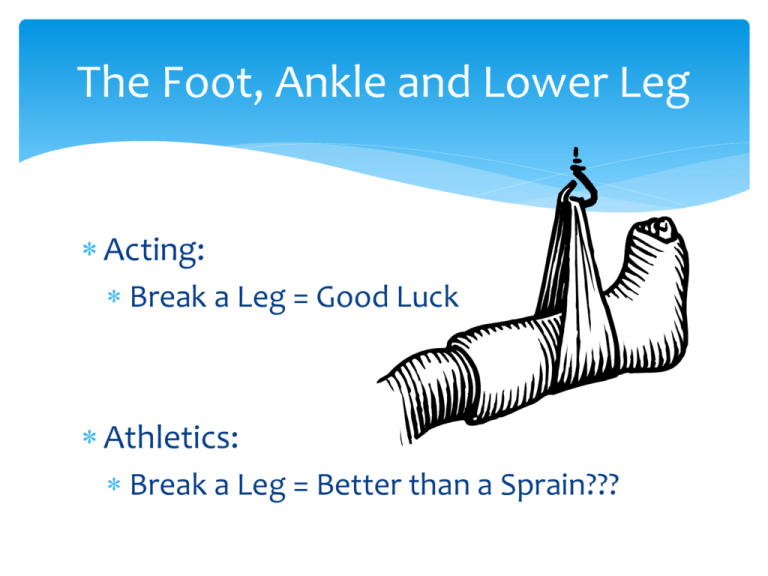
The Foot, Ankle and Lower Leg Acting: Break a Leg = Good Luck Athletics: Break a Leg = Better than a Sprain??? Anatomy & Physiology Limbs are part of the appendicular skeleton Skeleton: Aid movement Support and protect organs Produce red and white blood cells Store minerals Anatomy & Physiology Osteo = Bone Osteocyte: _____________________ Osteoblast: cells that produce more bone Osteoclasts: cells that absorb/digest bone The movement of a joint is determined by the shape of the bones in the joint Osteoblast activity Osteoclast activity Injury to bone Injury to skeleton/bone = fracture Most common in ankle and lower leg: Stress fracture Simple fracture Treatment of bone injury: Bone remodeling (cells) Reduction External fixation: Cast Rods Internal fixation: Surgery Wires Plates Screws Walking Boot/Brace vs Cast 1980 – fractured fibula - cast for 6-8 weeks 2014 – fractured fibula - walking boot or brace time dependent upon individual rate of healing Why? Muscle Atrophy Blood Pressure Muscle (Myo) Physiology Skeletal muscle Under voluntary control Aids in movement * Tendon * Attaches muscle to bone Characteristics of muscles Contractibility – ability to shorten (flexion) Excitability or irritability – ability to respond to electrical signals called action potentials Extensibility – ability to be stretched Elasticity – ability to return to original length after being stretched Muscle Physiology Muscle Anatomy Muscles attach to a bone that does not move (origin) And to a bone that does move (insertion) Most muscles are arranged in pairs Example: Bicep Curl Prime mover causes the main motion – bicep Antagonist opposes the main movement – tricep Synergist stabilizes movement Bicep Origin Bicep Insertion Muscle Biomechanics As a result of the structure of muscles and bones, MUSCLES ONLY PULL Therefore one muscle must pull in one direction – flexion (Bicep) While another muscle pulls in the opposite direction – extension (Tricep) Injury to Muscle sTrain Grade 1 stretching or slight tearing Grade 2 significant stretching and/or moderate tear Grade 3 muscle/tendon is torn Partial tear Rupture Ruptured Achilles Tendon GRAPHIC IMAGE Signs of Muscle Strain Pain Spasm Weakness Swelling Inflammation Cramping Loss of function Other Muscle Issues Atrophy write down an example of how a person could experience muscle atrophy Hypertrophy write down an example of how a person could experience muscle hypertrophy Muscle Tone Anatomy of Ligaments Made up of collagen fibers (75%) Fibroblasts – cells that form ligaments Considered inflexible – they don’t like to be stretched Ligaments are avascular – they do not have their own blood supply Little blood flow to middle region of ligament Blood flow is better at the origin and insertion – where the ligament is attached to bone Function of Ligaments Ligaments attach bone to bone Unlike tendons they resist being stretched, thus they are considered joint stabilizers Stretching can cause injury Hypermobility – genetics mostly Ligament Injuries sPrian Grade 1 overstretching or slight tearing of ligament Joint is still stable Grade 2 Partial ligament tear Grade 3 ligament is torn Partial tear Rupture Other Common Chronic Injuries Tendonitis – inflammation that occurs when tendon becomes irritated; overuse; chronic Bursitis – inflammation of the bursa (fluid-filled sac) resulting from repetitive movement or prolonged or excessive pressure Other Common Lower Leg Injuries Contusion – bruise Myositis ossificans can develop if a bruise/contusion is not managed properly Calcification forms within the muscle, restricting movement, increasing pain Surgery Nerves - Neuro Neurons send impulses down the length of the fiber, to the Neuromuscular synapse Neuromuscular synapse – the point at which the neuron signal crosses to the muscle, causing excitability (contract, relax) Injury to Nerves Injury to nerves can stop the flow of electrical activity to muscles, causing a loss of sensation and/or function Nerve injury can result from Cutting a nerve A nerve being compressed A nerve being overstretched Some nerve injuries can be corrected surgically or with time but severe injuries may result in permanent loss of function (paralysis) Neuroma A somewhat common nerve injury in the foot is called Morton’s Neuroma The nerves that run through the foot to the third and fourth metatarsals become compressed, irritated and damaged This compression creates enlargement of the nerve, eventually leading to permanent nerve damage. One of the most common causes is wearing shoes that have a tapered toe box, or highheeled shoes that cause the toes to be forced into the toe box. Ankle anatomy Directions: Label each part of the ankle using the following word key. Some words will not be used depending on the view of the ankle you are looking at. Color-code using the suggestions on the next page. Label each bone either weight-bearing or non-weight-bearing. Tibia Fibula Talus Calcaneus Lateral Malleolus Medial Malleolus Achilles tendon Deltoid ligament Anterior talofibular ligament Anterior tibiofibular ligament Posterior talofibular ligament Posterior tibiofibular ligament Calcaneofibular ligament LATERAL VIEW OF ANKLE Subtalar joint Talocrural joint Ankle anatomy Directions: Label each part of the ankle using the following word key. Some words will not be used depending on the view of the ankle you are looking at. Color-code using the suggestions on the next page. Label each bone either weight-bearing or non-weight-bearing. Tibia Fibula Talus Calcaneus Lateral Malleolus Medial Malleolus Achilles tendon Deltoid ligament Anterior talofibular ligament Anterior tibiofibular ligament Posterior talofibular ligament Posterior tibiofibular ligament Calcaneofibular ligament ANTERIOR VIEW OF ANKLE Subtalar joint Talocrural joint Common Foot & Ankle Injuries Plantar Fasciitis Common Foot & Ankle Injuries Shin Splints Medial Tibial Stress Syndrome NEXT SLIDE IS GRAPHIC! Achilles Tendonitis “Shredded” tendon Compartment Syndrome Compartment Syndrome NEXT SLIDE IS GRAPHIC! Compartment Syndrome Taping and Bracing: Which is the Better Option? Taping The purpose of a tape job is usually one of two things. One possible reason to tape an ankle is to prevent an ankle injury. Since most injuries occur due to an inversion (turning in of the ankle) and plantarflexion, most ankle tape jobs are applied so that they limit the inversion motion. Preventative Taping Preventative tape jobs are useful in situations of ankle weakness or when the likelihood of suffering an ankle injury is high due to the practice or game conditions. Gas pedal = Gastroc (jy) If the ankle is weak the athlete must also _____________________ the injured area Examples: Gas pedal ABC’s Toe raises Stretches Windshield wipers Toe taps Band exercises Protective Taping After an ankle sprain, the ligaments, muscles and tendons are weak and injured. In order to resume practice and play safely and swiftly, ankle tape jobs are often applied to protect the injury. Protective Taping Again, since most injuries are due to an inversion and plantarflexion mechanism, these tape jobs often center around preventing ____________ & ________. Mechanism of injury must be determined by an athletic trainer or doctor prior to return to play so that the tape job can be modified to protect against the exact mechanism of injury Disadvantages of taping Taping may weaken the body’s natural protective mechanisms Ligaments Muscles Tendons Joint capsule Taping tries to mimic what the ligaments are supposed to do. proprioception But what else should the athlete be doing? Many believe that regular use of a tape job will cause the secondary supports to become weaker and less effective, so that if the tape job fails or the athlete plays without it, injury is more likely. Disadvantages of taping One of the main problems with ankle tape jobs is that learning to tape is difficult. In other words, one must complete many tape jobs to become efficient. Another potential problem is that there is a great deal of variability between tape jobs applied by different people. A veteran trainer once commented that there are as many different ways to tape the ankle as there are people taping. Bracing An alternative to ankle taping is ankle bracing. Most sports medicine professionals prefer one over the other with some advocating taping and others bracing. In reality, there are probably uses for both. Advantages of Bracing Consistency – same feel every time Adjustable – unlike tape, if it’s too tight or too loose the user can easily make adjustments Self-reliance – unlike taping, you do not need anyone to put a brace on for you. You can use a brace even when a trainer is not available Custom-made option – you can buy a brace that has been made just for you. This option usually requires a doctors visit and a prescription for the type of brace you need Disadvantages Smelly-factor bacteria skin irritation discomfort gross! Over-the-counter option everyone can walk into a drug store and buy a brace, but that doesn’t mean that they know which brace is right for them and their injury. Easy access to a brace is good if you know how to shop for one, but can be a very bad thing if you get the wrong brace and end up doing more harm than good Con’s of Bracing, cont. Weakens the support structures in the ankle, just like tape does. The injured area gets dependent on the brace; patient MUST be doing rehab to ensure the injured area gets stronger! Injury Management Inflammation is a good thing for a short period of time. RICE helps flush out waste products (dead cells) and bring in healthy oxygenated cells to help repair the Damage. Wrapping an ankle Distal to proximal Snug but not too tight Do NOT sleep with a wrap on Felt or Foam horseshoe cut-out Can also ice while wrapped Rehabilitation Exercise Progression is critical! Non-weight bearing ROM Weight-bearing ROM & strengthening Proprioception Functional Don’t skip steps in the process Progressive Rehabilitation Non Weight-bearing ABC’s Gas pedal Seated toe taps Windshield wipers Weight-bearing Heel raises Heel to Toe walking Band exercises Rehabilitation Exercise Proprioception Balance exercises Eyes closed exercises Rocker board Functional Agility Sport-specific movements Which of these are… Non-weight-bearing? Weight-bearing? Proprioception These exercises would be classified as… These exercises are shown using a Bosu Board but you could also use a rocker or wobble board " The 20 benefits of ankle taping > ManageYourLifeNow.com." Manage Your Life Better with ManageYourLifeNow.com. N.p., 13 Jan. 2009. Web. 11 Apr. 2010. <http://www.manageyourlifenow.com/>. "People who exercise on work days are happier, suffer less stress and are more productive." Mail Online. N.p., 16 Dec. 2008. Web. 11 Apr. 2010. <http://www.dailymail.co.uk/news/>. "The FITT Principle of Training." Phil Davies' Sports Fitness Advisor - Get Fit for Sport & Life. Sports Fitness Advisor, n.d. Web. 11 Apr. 2010. <http://www.sport-fitness-advisor.com/fitt-principle.html>. Bolton, Raphael. "Exercising Properly With Aerobic And Anaerobic Exercises." Article Alley. N.p., 1 Apr. 2010. Web. 11 Apr. 2010. <http://www.articlealley.com/>. Bronson, Mary. Glencoe Health. Woodland Hills; TIME,2009.335.print

